Hongyu Chen
UML-CoT: Structured Reasoning and Planning with Unified Modeling Language for Robotic Room Cleaning
Sep 26, 2025Abstract:Chain-of-Thought (CoT) prompting improves reasoning in large language models (LLMs), but its reliance on unstructured text limits interpretability and executability in embodied tasks. Prior work has explored structured CoTs using scene or logic graphs, yet these remain fundamentally limited: they model only low-order relations, lack constructs like inheritance or behavioral abstraction, and provide no standardized semantics for sequential or conditional planning. We propose UML-CoT, a structured reasoning and planning framework that leverages Unified Modeling Language (UML) to generate symbolic CoTs and executable action plans. UML class diagrams capture compositional object semantics, while activity diagrams model procedural control flow. Our three-stage training pipeline combines supervised fine-tuning with Group Relative Policy Optimization (GRPO), including reward learning from answer-only data. We evaluate UML-CoT on MRoom-30k, a new benchmark of cluttered room-cleaning scenarios. UML-CoT outperforms unstructured CoTs in interpretability, planning coherence, and execution success, highlighting UML as a more expressive and actionable structured reasoning formalism.
Teaching in adverse scenes: a statistically feedback-driven threshold and mask adjustment teacher-student framework for object detection in UAV images under adverse scenes
Jun 12, 2025



Abstract:Unsupervised Domain Adaptation (UDA) has shown promise in effectively alleviating the performance degradation caused by domain gaps between source and target domains, and it can potentially be generalized to UAV object detection in adverse scenes. However, existing UDA studies are based on natural images or clear UAV imagery, and research focused on UAV imagery in adverse conditions is still in its infancy. Moreover, due to the unique perspective of UAVs and the interference from adverse conditions, these methods often fail to accurately align features and are influenced by limited or noisy pseudo-labels. To address this, we propose the first benchmark for UAV object detection in adverse scenes, the Statistical Feedback-Driven Threshold and Mask Adjustment Teacher-Student Framework (SF-TMAT). Specifically, SF-TMAT introduces a design called Dynamic Step Feedback Mask Adjustment Autoencoder (DSFMA), which dynamically adjusts the mask ratio and reconstructs feature maps by integrating training progress and loss feedback. This approach dynamically adjusts the learning focus at different training stages to meet the model's needs for learning features at varying levels of granularity. Additionally, we propose a unique Variance Feedback Smoothing Threshold (VFST) strategy, which statistically computes the mean confidence of each class and dynamically adjusts the selection threshold by incorporating a variance penalty term. This strategy improves the quality of pseudo-labels and uncovers potentially valid labels, thus mitigating domain bias. Extensive experiments demonstrate the superiority and generalization capability of the proposed SF-TMAT in UAV object detection under adverse scene conditions. The Code is released at https://github.com/ChenHuyoo .
PiFlow: Principle-aware Scientific Discovery with Multi-Agent Collaboration
May 21, 2025
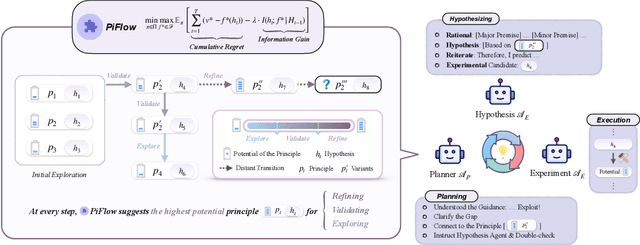
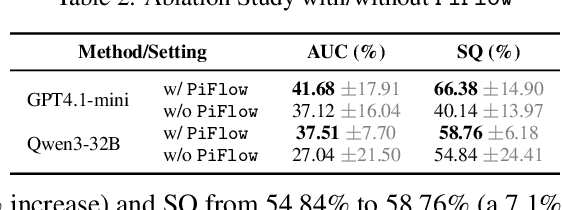
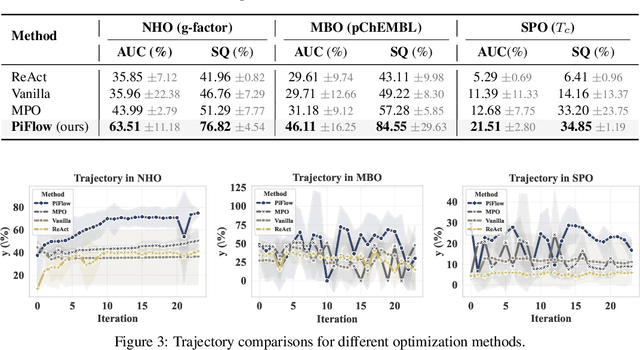
Abstract:Large Language Model (LLM)-based multi-agent systems (MAS) demonstrate remarkable potential for scientific discovery. Existing approaches, however, often automate scientific discovery using predefined workflows that lack rationality constraints. This often leads to aimless hypothesizing and a failure to consistently link hypotheses with evidence, thereby hindering systematic uncertainty reduction. Overcoming these limitations fundamentally requires systematic uncertainty reduction. We introduce \texttt{PiFlow}, an information-theoretical framework, treating automated scientific discovery as a structured uncertainty reduction problem guided by principles (e.g., scientific laws). In evaluations across three distinct scientific domains -- discovering nanomaterial structures, bio-molecules, and superconductor candidates with targeted properties -- our method significantly improves discovery efficiency, reflected by a 73.55\% increase in the Area Under the Curve (AUC) of property values versus exploration steps, and enhances solution quality by 94.06\% compared to a vanilla agent system. Overall, \texttt{PiFlow} serves as a Plug-and-Play method, establishing a novel paradigm shift in highly efficient automated scientific discovery, paving the way for more robust and accelerated AI-driven research. Code is publicly available at our \href{https://github.com/amair-lab/PiFlow}{GitHub}.
Command A: An Enterprise-Ready Large Language Model
Apr 01, 2025



Abstract:In this report we describe the development of Command A, a powerful large language model purpose-built to excel at real-world enterprise use cases. Command A is an agent-optimised and multilingual-capable model, with support for 23 languages of global business, and a novel hybrid architecture balancing efficiency with top of the range performance. It offers best-in-class Retrieval Augmented Generation (RAG) capabilities with grounding and tool use to automate sophisticated business processes. These abilities are achieved through a decentralised training approach, including self-refinement algorithms and model merging techniques. We also include results for Command R7B which shares capability and architectural similarities to Command A. Weights for both models have been released for research purposes. This technical report details our original training pipeline and presents an extensive evaluation of our models across a suite of enterprise-relevant tasks and public benchmarks, demonstrating excellent performance and efficiency.
Efficient Inference for Large Reasoning Models: A Survey
Mar 29, 2025
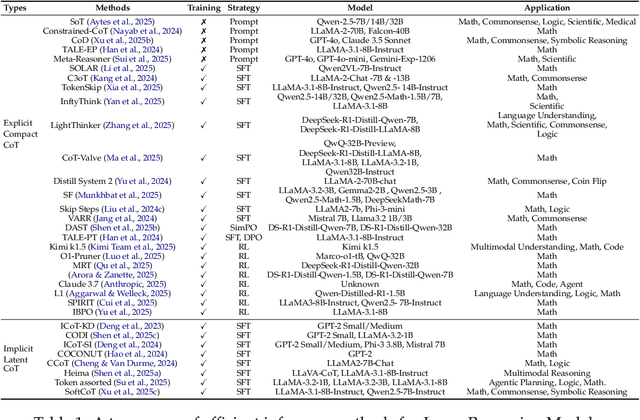

Abstract:Large Reasoning Models (LRMs) significantly improve the reasoning ability of Large Language Models (LLMs) by learning to reason, exhibiting promising performance in complex task-solving. However, their deliberative reasoning process leads to inefficiencies in token usage, memory consumption, and inference time. Thus, this survey provides a review of efficient inference methods designed specifically for LRMs, focusing on mitigating token inefficiency while preserving the reasoning quality. First, we introduce a taxonomy to group the recent methods into two main categories: (a) explicit compact Chain-of-Thought (CoT), which reduces tokens while keeping the explicit reasoning structure, and (b) implicit latent CoT, which encodes reasoning steps within hidden representations instead of explicit tokens. Meanwhile, we discuss their strengths and weaknesses. Then, we conduct empirical analyses on existing methods from performance and efficiency aspects. Besides, we present open challenges in this field, including human-centric controllable reasoning, trade-off between interpretability and efficiency of reasoning, ensuring safety of efficient reasoning, and broader applications of efficient reasoning. In addition, we highlight key insights for enhancing LRMs' inference efficiency via techniques such as model merging, new architectures, and agent routers. We hope this work serves as a valuable guide, helping researchers overcome challenges in this vibrant field\footnote{https://github.com/yueliu1999/Awesome-Efficient-Inference-for-LRMs}.
Exploring Hallucination of Large Multimodal Models in Video Understanding: Benchmark, Analysis and Mitigation
Mar 25, 2025
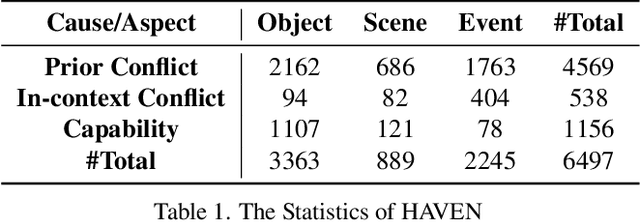


Abstract:The hallucination of large multimodal models (LMMs), providing responses that appear correct but are actually incorrect, limits their reliability and applicability. This paper aims to study the hallucination problem of LMMs in video modality, which is dynamic and more challenging compared to static modalities like images and text. From this motivation, we first present a comprehensive benchmark termed HAVEN for evaluating hallucinations of LMMs in video understanding tasks. It is built upon three dimensions, i.e., hallucination causes, hallucination aspects, and question formats, resulting in 6K questions. Then, we quantitatively study 7 influential factors on hallucinations, e.g., duration time of videos, model sizes, and model reasoning, via experiments of 16 LMMs on the presented benchmark. In addition, inspired by recent thinking models like OpenAI o1, we propose a video-thinking model to mitigate the hallucinations of LMMs via supervised reasoning fine-tuning (SRFT) and direct preference optimization (TDPO)-- where SRFT enhances reasoning capabilities while TDPO reduces hallucinations in the thinking process. Extensive experiments and analyses demonstrate the effectiveness. Remarkably, it improves the baseline by 7.65% in accuracy on hallucination evaluation and reduces the bias score by 4.5%. The code and data are public at https://github.com/Hongcheng-Gao/HAVEN.
Safer or Luckier? LLMs as Safety Evaluators Are Not Robust to Artifacts
Mar 12, 2025



Abstract:Large Language Models (LLMs) are increasingly employed as automated evaluators to assess the safety of generated content, yet their reliability in this role remains uncertain. This study evaluates a diverse set of 11 LLM judge models across critical safety domains, examining three key aspects: self-consistency in repeated judging tasks, alignment with human judgments, and susceptibility to input artifacts such as apologetic or verbose phrasing. Our findings reveal that biases in LLM judges can significantly distort the final verdict on which content source is safer, undermining the validity of comparative evaluations. Notably, apologetic language artifacts alone can skew evaluator preferences by up to 98\%. Contrary to expectations, larger models do not consistently exhibit greater robustness, while smaller models sometimes show higher resistance to specific artifacts. To mitigate LLM evaluator robustness issues, we investigate jury-based evaluations aggregating decisions from multiple models. Although this approach both improves robustness and enhances alignment to human judgements, artifact sensitivity persists even with the best jury configurations. These results highlight the urgent need for diversified, artifact-resistant methodologies to ensure reliable safety assessments.
Bring Remote Sensing Object Detect Into Nature Language Model: Using SFT Method
Mar 11, 2025



Abstract:Recently, large language models (LLMs) and visionlanguage models (VLMs) have achieved significant success, demonstrating remarkable capabilities in understanding various images and videos, particularly in classification and detection tasks. However, due to the substantial differences between remote sensing images and conventional optical images, these models face considerable challenges in comprehension, especially in detection tasks. Directly prompting VLMs with detection instructions often fails to yield satisfactory results. To address this issue, this letter explores the application of VLMs for object detection in remote sensing images. Specifically, we utilize publicly available remote sensing object detection datasets, including SSDD, HRSID, and NWPU-VHR-10, to convert traditional annotation information into natural language, thereby constructing an instruction-tuning (SFT) dataset for VLM training. We then evaluate the detection performance of different fine-tuning strategies for VLMs and obtain optimized model weights for object detection in remote sensing images. Finally, we assess the model's prior knowledge capabilities through natural language queries.Experimental results demonstrate that, without modifying the model architecture, remote sensing object detection can be effectively achieved using natural language alone. Additionally, the model exhibits the ability to perform certain vision question answering (VQA) tasks. Our dataset and relevant code will be released soon.
EquiBench: Benchmarking Code Reasoning Capabilities of Large Language Models via Equivalence Checking
Feb 18, 2025



Abstract:Equivalence checking, i.e., determining whether two programs produce identical outputs for all possible inputs, underpins a broad range of applications, including software refactoring, testing, and optimization. We present the task of equivalence checking as a new way to evaluate the code reasoning abilities of large language models (LLMs). We introduce EquiBench, a dataset of 2400 program pairs spanning four programming languages and six equivalence categories. These pairs are systematically generated through program analysis, compiler scheduling, and superoptimization, covering nontrivial structural transformations that demand deep semantic reasoning beyond simple syntactic variations. Our evaluation of 17 state-of-the-art LLMs shows that OpenAI o3-mini achieves the highest overall accuracy of 78.0%. In the most challenging categories, the best accuracies are 62.3% and 68.8%, only modestly above the 50% random baseline for binary classification, indicating significant room for improvement in current models' code reasoning capabilities.
Tumor Detection, Segmentation and Classification Challenge on Automated 3D Breast Ultrasound: The TDSC-ABUS Challenge
Jan 26, 2025



Abstract:Breast cancer is one of the most common causes of death among women worldwide. Early detection helps in reducing the number of deaths. Automated 3D Breast Ultrasound (ABUS) is a newer approach for breast screening, which has many advantages over handheld mammography such as safety, speed, and higher detection rate of breast cancer. Tumor detection, segmentation, and classification are key components in the analysis of medical images, especially challenging in the context of 3D ABUS due to the significant variability in tumor size and shape, unclear tumor boundaries, and a low signal-to-noise ratio. The lack of publicly accessible, well-labeled ABUS datasets further hinders the advancement of systems for breast tumor analysis. Addressing this gap, we have organized the inaugural Tumor Detection, Segmentation, and Classification Challenge on Automated 3D Breast Ultrasound 2023 (TDSC-ABUS2023). This initiative aims to spearhead research in this field and create a definitive benchmark for tasks associated with 3D ABUS image analysis. In this paper, we summarize the top-performing algorithms from the challenge and provide critical analysis for ABUS image examination. We offer the TDSC-ABUS challenge as an open-access platform at https://tdsc-abus2023.grand-challenge.org/ to benchmark and inspire future developments in algorithmic research.
 Add to Chrome
Add to Chrome Add to Firefox
Add to Firefox Add to Edge
Add to Edge